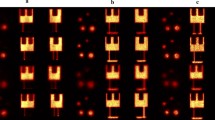Abstract.
State of the art positron emission tomography (PET) systems allow for scatter and attenuation correction. However, the size of the structure being studied and the region of interest (ROI) chosen also influence the accuracy of measurements of radioactive concentration. Furthermore, the limited spatial resolution of PET tomographs, which depends, among other factors, on the range of positrons in matter, can also contribute to a loss in quantitation accuracy. In this paper we address the influence of positron range, structure size and ROI size on the quantitation of radioactive concentration using PET. ECAT EXACT HR+ (HR+) and ECAT 953B/31 (ECAT 953B) PET systems were used in phantom acquisitions performed with two radioisotopes with different positron ranges. The 3D Hoffman phantom was scanned on both scanners with both radioisotopes, to visually analyse the image quality. A resolution phantom having six spheres of different diameters in a Plexiglas cylinder was used to calculate the values of the contrast recovery coefficient or hot spot recovery coefficient and of the spill-over or cold spot recovery coefficient under different imaging conditions used in clinical routine at our institution. Activity ratios were varied between 2 and 30 or between 0.4 and 200 by filling the spheres with fluorine-18 or bromine-76 respectively and the cylinder with 11C. Dynamic scans were performed on each scanner. Data were reconstructed using the same parameters as are used in clinical protocols. The variations in sphere and cylinder activities with time were fitted using the function M(t)=k 1·A(t)+k 2.B(t), where M(t) is the radioactivity concentration measured in an ROI placed on each sphere and A(t) and B(t) represent the true radioactivity concentrations present at time t in the spheres and in the cylinder respectively. k 1 and k 2 are factors representing the contrast recovery coefficient and the spill-over from surrounding activity on measurements respectively. The visual analysis of images obtained using a 3D Hoffman phantom showed that image resolution and image contrast between different regions are radioisotope dependent and clearly better when using 18F. Linear profiles taken on these images confirmed the visual assessment. For a given scanner, the k 1 values obtained with 18F were systematically higher than those measured using 76Br in the same machine (especially for the smaller spheres) when using the same ROI. For a sphere of a particular diameter, the use of a wider ROI resulted in lower quantitative accuracy when using the same isotope and the same camera. Lower quantitative accuracy was found for smaller spheres for all ROI sizes used in image analysis. For the same scanner and for a similar imaging situation (same sphere and same ROI), it was found that k 1 and k 2 values depend on the radioisotope used. For the same isotope and tomograph, the k 1 values obtained decreased with the size of the structures imaged, as well as with the increase in ROI size. The use of a tomograph with better spatial resolution (HR+, rather than ECAT 953B) greatly increased the k 1 values for 18F while only a mild improvement in these values was observed for 76Br. The use of 76Br led to k 2 values that were slightly higher than those measured using 18F. These differences may have been due to the difference in the range of the positrons emitted by the radioisotopes used in this study. The measurements performed in this study show that the comparison of studies obtained on the same camera depends on the radioisotope used and may require the adaptation of ROI size between examinations. Marked differences are visible if the positron ranges of such radioisotopes are very different. Therefore, when employing commercially available tomographs and imaging protocols used in clinical routine, the effects of differences in positron range on image quality and quantitation are noticeable and correction for these effects may be of importance. With the arrival of PET imaging systems with better spatial resolution (close to 2 mm full-width at half-maximum for animal PET systems), positron range will have an increasing influence on the image quality and on the choice of radioisotope for a given application.
Similar content being viewed by others
Author information
Authors and Affiliations
Additional information
Received 30 January and in revised form 18 March 1999
Rights and permissions
About this article
Cite this article
Ribeiro, M., Almeida, P., Strul, D. et al. Comparison of fluorine-18 and bromine-76 imaging in positron emission tomography. Eur J Nucl Med 26, 758–766 (1999). https://doi.org/10.1007/s002590050447
Issue Date:
DOI: https://doi.org/10.1007/s002590050447




